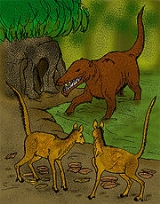
Dichobunidae
Encyclopedia
Dichobunidae is an extinct family
of early even-toed hoofed mammals (artiodactyls) known from the early Eocene
to late Oligocene
of North America
, Europe
, and Asia
. Dichobunidae includes some of the earliest known artiodactyls, such as Diacodexis
.
They were small animals, about the size of a modern rabbit, and had many primitive features. In life, they would have appeared similar to a long-tailed muntjac. They had four or five toes on each foot, with each toe ending in a small hoof. They had a complete set of teeth, unlike most later artiodactyls, with their more specialist dentitions. The shape of the teeth suggests that they were browsers, feeding off small leaves, perhaps in the forest undergrowth. The shape of their body and limbs suggests they would have been fast running animals, unlike most of their contemporaries.
Family (biology)
In biological classification, family is* a taxonomic rank. Other well-known ranks are life, domain, kingdom, phylum, class, order, genus, and species, with family fitting between order and genus. As for the other well-known ranks, there is the option of an immediately lower rank, indicated by the...
of early even-toed hoofed mammals (artiodactyls) known from the early Eocene
Eocene
The Eocene Epoch, lasting from about 56 to 34 million years ago , is a major division of the geologic timescale and the second epoch of the Paleogene Period in the Cenozoic Era. The Eocene spans the time from the end of the Palaeocene Epoch to the beginning of the Oligocene Epoch. The start of the...
to late Oligocene
Oligocene
The Oligocene is a geologic epoch of the Paleogene Period and extends from about 34 million to 23 million years before the present . As with other older geologic periods, the rock beds that define the period are well identified but the exact dates of the start and end of the period are slightly...
of North America
North America
North America is a continent wholly within the Northern Hemisphere and almost wholly within the Western Hemisphere. It is also considered a northern subcontinent of the Americas...
, Europe
Europe
Europe is, by convention, one of the world's seven continents. Comprising the westernmost peninsula of Eurasia, Europe is generally 'divided' from Asia to its east by the watershed divides of the Ural and Caucasus Mountains, the Ural River, the Caspian and Black Seas, and the waterways connecting...
, and Asia
Asia
Asia is the world's largest and most populous continent, located primarily in the eastern and northern hemispheres. It covers 8.7% of the Earth's total surface area and with approximately 3.879 billion people, it hosts 60% of the world's current human population...
. Dichobunidae includes some of the earliest known artiodactyls, such as Diacodexis
Diacodexis
Diacodexis is an extinct genus of small herbivore mammal belonging to the family Dichobunidae which lived in North America and Asia from 55.4 mya—46.2 mya. and existing for approximately ....
.
They were small animals, about the size of a modern rabbit, and had many primitive features. In life, they would have appeared similar to a long-tailed muntjac. They had four or five toes on each foot, with each toe ending in a small hoof. They had a complete set of teeth, unlike most later artiodactyls, with their more specialist dentitions. The shape of the teeth suggests that they were browsers, feeding off small leaves, perhaps in the forest undergrowth. The shape of their body and limbs suggests they would have been fast running animals, unlike most of their contemporaries.
Taxonomy
Classification of dichobunids following McKenna and Bell:- †ExtinctionIn biology and ecology, extinction is the end of an organism or of a group of organisms , normally a species. The moment of extinction is generally considered to be the death of the last individual of the species, although the capacity to breed and recover may have been lost before this point...
Family Dichobunidae- Paraphenacodus
- Dulcidon
- Chorlakkia
- Pakibune
- Subfamily Dichobuninae
- Tribe Hyperdichobunini
- Mouillacitherium
- Hyperdichobune
- Tribe Dichobunini
- Aumelasia
- Meniscodon
- MesselobunodonMesselobunodonMesselobunodon is an extinct genus of early even-toed ungulate....
- Dichobune
- Buxobune
- Neufferia
- Metriotherium
- Synaphodus
- Tribe Hyperdichobunini
- Subfamily Diacodexeinae
- DiacodexisDiacodexisDiacodexis is an extinct genus of small herbivore mammal belonging to the family Dichobunidae which lived in North America and Asia from 55.4 mya—46.2 mya. and existing for approximately ....
- Bunophorus
- Protodichobune
- Lutzia
- Tapochoerus
- Neodiacodexis
- Diacodexis
- Subfamily Homacodontinae
- Tribe Bunomerycini
- Bunomeryx
- Hylomeryx
- Mesomeryx
- Mytonomeryx
- Pentacemylus
- Tribe Homacodontini
- Hexacodus
- Antiacodon
- Eygalayodon
- Homacodon
- Auxontodon
- Microsus
- Texodon
- Tribe Bunomerycini
- Subfamily Leptochoerinae
- Stibarus
- Ibarus
- Laredochoerus
- Leptochoerus

